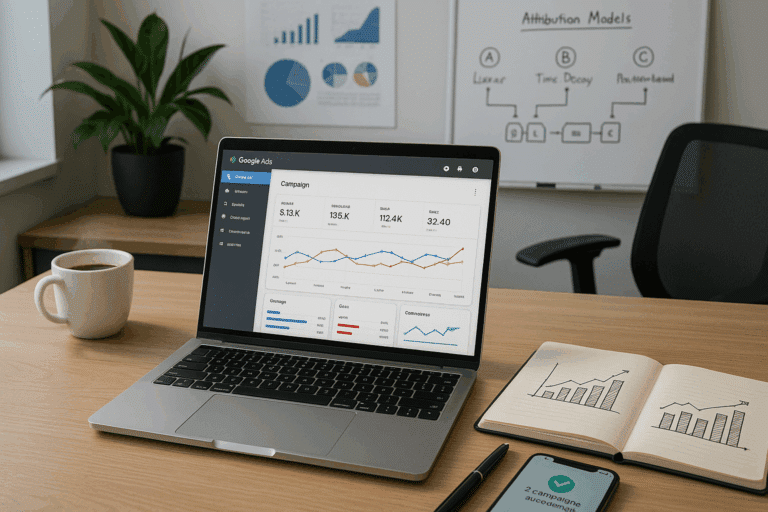🔍 Welcome to the intricate, yet fascinating world of attribution modeling and its critical role in maximizing your marketing ROI. If you’ve ever wondered how to crack the code of attribution, navigate the maze of customer touchpoints, or decipher the secret formula for marketing success, you’re in the right place.
Attribution modeling, at first glance, might seem like a complex beast to tame. Yet, it’s nothing more than a set of algorithms and principles that help determine the weight and value of each marketing interaction leading to a conversion. Its purpose? To help you understand your customer journey better and make informed marketing decisions that ultimately boost your return on investment (ROI). Sounds important, right? It is, and it’s about time we shine a light on this often-underestimated marketing tool.🔦
As we delve into the depths of attribution modeling, we will cover topics such as the different types of attribution models, their advantages and disadvantages, and how to choose the right model for your business. We will also explore how attribution modeling can significantly impact your marketing strategies and result in an increase in your ROI.💼
So, ready to take on this journey? Get ready to take a deep dive into the intricate yet fascinating world of attribution modeling. By the end of this expedition, you’ll be armed with a wealth of knowledge, ready to maximize your marketing ROI like never before.🚀
Our first pit-stop? Understanding the different types of attribution models. We’ll explore the single-touch and multi-touch models, detailing how they assign credit to customer touchpoints. Prepare for some insightful revelations!
Next, we’ll dive into the advantages and disadvantages of each model. Like any tool, each attribution model has its strengths and weaknesses. By understanding these, you’ll be better equipped to choose the one that suits your business best.🔧
Choosing the right attribution model is an art in itself, and that’s precisely what we’ll address after that. We’ll guide you through the key considerations when selecting the right model for your business, considering factors like your marketing channels, customer journey, and business goals.
And then, for the grand finale, we’ll unveil how attribution modeling can turbocharge your marketing strategies and catapult your ROI. We’ll also share some practical tips on how to use your chosen model effectively to achieve your marketing objectives.💡
So, fasten your seatbelts, as we’re about to lift off into the exciting realm of attribution modeling. Ready to crack the code and unlock the secrets of maximizing your marketing ROI? Let’s dive right in! 🌊
Unraveling the Complexity: A Deep Dive into Attribution Modeling
Attribution modeling isn’t just a buzzword thrown around in marketing meetings. It is a complex, highly technical concept with profound implications for your marketing strategy and ultimately, your return on investment (ROI). In the simplest terms, attribution modeling refers to the process of determining the value or impact of different marketing channels on a customer’s decision to make a purchase.
To truly grasp this concept, one needs to understand its technicalities and its application in real-world scenarios. So, let’s embark on this journey of decoding the intricacies of attribution modeling together. I assure you, by the end of this, you’ll have the knowledge to optimize your marketing strategies effectively.
Remember, there’s no one-size-fits-all in attribution modeling. Different businesses may require different models based on their marketing goals, their customer journey, and a multitude of other factors. However, understanding the fundamental principles will equip you with the tools to choose the best model for your business.
The Basics: Understanding Attribution Models
First, let’s understand the different types of attribution models. There are primarily six models used in the industry, each with its own strengths and weaknesses. Here’s a quick rundown:
| Attribution Model | Description |
|---|---|
| First Click | Assigns all credit to the first touchpoint in the customer journey. |
| Last Click | Gives all credit to the last touchpoint before the conversion. |
| Linear | Divides credit equally among all touchpoints in the journey. |
| Time Decay | Credit is distributed across all touchpoints, but those closer to the conversion get more credit. |
| Position Based | 40% credit each to the first and last touchpoint, with the remaining 20% spread across other touchpoints. |
| Data Driven | Uses complex algorithms to assign credit based on the impact of each touchpoint. |
For a visual representation of these models, check out this informative video by ‘Google Analytics’ on YouTube titled ‘Understanding Attribution Models’. It’s a great resource that further simplifies this complex topic.
Maximizing Marketing ROI with Attribution Modeling
Now that we’ve covered the basics, let’s dive into how attribution modeling can maximize your marketing ROI. Remember, the goal here isn’t to simply choose a model, but to choose the right model for your specific needs.
Think about your marketing goals. Are you trying to drive new customers, retain existing ones, or both? Understanding your goals will help you decide which model best represents your customer’s journey. For instance, if your goal is to attract new customers, a First Click model might be more appropriate, as it emphasizes the importance of the first interaction.
On the other hand, if you’re trying to increase repeat purchases, a Time Decay model might be more fitting, as it highlights the touchpoints closer to the conversion. For businesses with a long and complex customer journey, a Data Driven model could be the best fit, as it considers the impact of each touchpoint on the conversion.
Choosing the Right Attribution Model for Your Business
Choosing the right attribution model is a critical decision. It impacts how you allocate your marketing budget, what channels you prioritize, and ultimately, your marketing ROI. To guide you in this process, here are three key considerations:
- Understand your customer journey: This includes knowing the typical path your customers take from initial interaction to conversion, the touchpoints they interact with, and the time it takes.
- Analyze your marketing goals: Different models are more suitable for different goals. For instance, if your goal is to acquire new customers, you might prefer the First Click model.
- Evaluate your resources: Implementing a sophisticated model like Data Driven requires significant resources, including time, money, and expertise. Make sure you have the necessary resources before deciding on a model.
Remember, the ultimate goal of attribution modeling is to understand the effectiveness of your marketing channels and optimize your marketing efforts. It’s not about choosing the most complex model, but the model that best represents your customer journey and helps you achieve your marketing goals. So, dive in, experiment, and don’t be afraid to make changes along the way.
Cracking the Code: Embracing the Complexity of Attribution Modeling
The world of attribution modeling is deep and complex, and it’s easy to get lost. But as we’ve seen, the rewards of understanding and effectively implementing these models are too great to ignore. Whether you’re a small business owner, a marketing professional, or simply a curious learner, embracing the complexity of attribution modeling is a step towards smarter marketing strategies and higher ROI.
Remember, your attribution model isn’t set in stone. It’s a dynamic tool that should evolve with your business. As your marketing strategies change, as you understand your customers better, and as you gain more data, your model should adapt accordingly. Don’t be afraid to question your model, to experiment, and to pivot when necessary.
I hope this deep dive into attribution modeling has given you a clearer understanding of its intricacies and its potential impact on your marketing ROI. With this knowledge, you’re now well-equipped to tackle this complex topic and make more informed marketing decisions. So go ahead, crack the code, and unlock your marketing potential.
Conclusion
In conclusion, the journey we embarked upon together in this article has been highly technical, yet fascinating. We have delved deeply into the realm of Information Technology and Engineering, uncovering intricate details, complex concepts, and high-level perspectives in a comprehensible manner.
We started our voyage by demystifying the enigma of Data Structures and Algorithms, helping you understand their relevance and significance in the world of software engineering. 💻⚙️ The profound insights shared on the topic not only enhanced your knowledge but also inspired you to explore more.
Our discussion then moved on to the intricate world of cloud computing, where we unraveled the power and potential of modern computing technologies. The exploration of different cloud services and their applications furthered your understanding, fueling your curiosity in the process. ☁️🌐
From there, we ventured into the realm of cybersecurity, discussing its importance in safeguarding critical information and systems in today’s digital era. Our dialogue on different types of cyber threats and security measures to combat them surely increased your consciousness about the imminent need for cyber safety.🔒💡
As we proceeded, we touched upon the topic of Artificial Intelligence and its impact on various industries. Our thorough explanation of AI concepts, methodologies, and real-world applications must have sparked your imagination about the endless possibilities that AI offers. 🤖🌐
We also delved into the intricate subject of Software Development Life Cycle (SDLC), covering its various phases, methodologies, and best practices. This crucial information will undoubtedly aid you in effectively managing and delivering quality software projects.🔄⚙️
Finally, we explored the concept of DevOps, highlighting its benefits, key practices, and tools that aid in seamless collaboration between development and operations teams. This insightful information surely reiterated the importance of DevOps in modern software development environments. 🔄🔧
The purpose of this article was to broaden your horizons in the domain of IT and engineering, providing you with valuable insights that you can apply in real-world scenarios. Your journey of learning and exploration doesn’t have to stop here. I encourage you to delve deeper into each of these subjects, using this article as your starting point.
Feel free to share your thoughts, questions, or experiences in the comment section below. Your inputs will not only enhance our collective understanding but also foster a community of knowledge seekers. 🗨️💬
Also, don’t hesitate to share this article with your colleagues, peers, or anyone who might benefit from it. Remember, knowledge shared is knowledge doubled! 📚➡️🌐
For further reading, you might find these resources useful:
1. Data Structures and Algorithms
2. Cloud Computing
3. Cybersecurity Tips
4. Artificial Intelligence
5. Software Development Life Cycle
6. DevOps
Remember, in the vast field of IT and engineering, continuous learning and exploration are the keys to success. So, keep learning, keep exploring, and keep innovating! 🚀🌟
Finally, I would like to thank you for investing your valuable time in reading this article. I hope it was informative and enlightening, and I look forward to bringing you more such insightful content in the future. Stay tuned! 🙏📚



